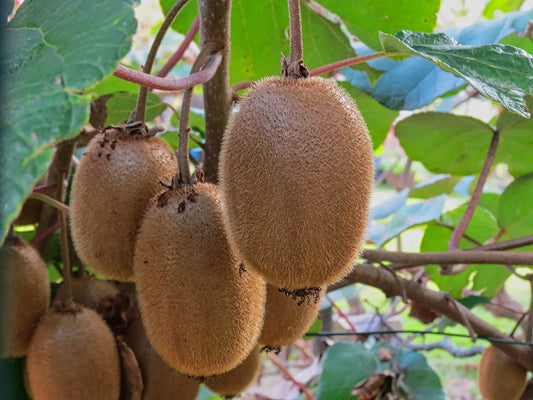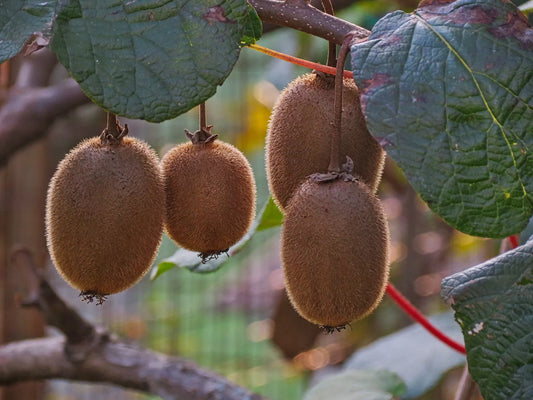-
Delivery from 10 plants to France, Switzerland and Europe
-
Kiwi Plants Wholesale Supplier
-
Quality Kiwi Plants
-
Secure payment - 3X payment
Our Male / Female Kiwi plants (Dioecious plants)
The prices shown are our base prices for large volumes. Depending on the quantity ordered and the producers’ pricing scales, the rate may be adjusted upward. Each quote is personalized to ensure you receive a fair price.
-
Kiwi Tomuri plant franc - 2.5 Liter pot (13X13X18) conventional
Regular price €8,50 EURRegular price -
Hayward Kiwi Plant - 1 Year Old Bare Roots Diameter 10+ Conventional
Regular price €9,00 EURRegular price -
Kiwi Tomuri plant - bare-root 1 year old diameter 10+ conventional
Regular price €9,00 EURRegular price -
Hayward Kiwi Plant - 1 Year Bare Root Diameter 12+ Conventional
Regular price €9,40 EURRegular price -
Kiwi Tomuri plant - bare-root 1 year old diameter 12+ conventional
Regular price €9,40 EURRegular price -
Hayward Kiwi Grafted on Roki - 1 Year Old Conventional Bare Root
Regular price €11,00 EURRegular price -
Hayward Kiwi grafted onto Bounty 71 - 1 year old conventional bare-root
Regular price €11,00 EURRegular price -
Tomuri kiwi grafted on Bounty 71 - 1 year old conventional bare-root
Regular price €11,00 EURRegular price -
Tomuri kiwi grafted onto Roki - 1 year old conventional bare-root
Regular price €11,00 EURRegular price
Collapsible content
When to Plant? When to Harvest? - Growing Guide / Diseases / Pests
You can find all our planting advice for kiwis in France here.
How profitable is kiwi production in France?
Planting / Harvesting Calendar:
Kiwi Planting and Harvesting Calendar
Production schedule for a one-hectare plot of kiwi
Self-fertile / Male Female
What is a self-fertile plant? Our self-fertile kiwi plants
What is a Male/Female plant? Our Male/Female Kiwi plants (Dioecious plants)
Kiwi Pollination - How to Promote It?
Free Plants, Grafted Plants, Rootstocks:
Kiwi - Rootstock or Free Plants: How to Choose?
Kiwi Rootstock Comparison: Bounty 71 vs Roki
Kiwi Grafting Techniques for Professionals
Plot layout / Planting technique
T-bar Method: The T-bar Method: A Complete Guide to Planting Kiwis in France
Pergola Method: The Pergola Method: A Complete Guide to Planting Kiwis in France
Fertilization / manuring of kiwi from planting to production
Kiwi Bud Break - Guide to Successful Kiwi Bud Break
Lignification - Optimizing lignification / Heightening of kiwis
Kiwi Pruning - How to Optimize Kiwi Pruning in France for Exceptional Fruit Production
Kiwi Plants In Vitro - Micro Propagation of Kiwi Plants
Kiwi - Thinning Kiwis. Why and When to Do It?
When and how to harvest kiwis?
Irrigation / Antifreeze System
Kiwi Irrigation - Water Needs of Kiwi Farms in Southern France
Antifreeze System - Antifreeze spray for kiwis: an essential solution for professional producers
Diseases that can affect kiwi crops in France
Fighting Kiwi Bacterial Canker: Symptoms, Prevention, and Professional Solutions
Fighting Kiwi Botrytis: Symptoms, Prevention and Professional Solutions
Fighting Kiwi Phytophthora: Symptoms, Prevention and Professional Solutions
Fighting Sooty Leaf and Fly Dropping Disease in Kiwi Crops: Symptoms, Prevention and Professional Solutions
Fighting Kiwi Scab: Symptoms, Prevention and Professional Solutions
Fighting Kiwi Anthracnose: Symptoms, Prevention and Professional Solutions
Fighting Kiwi Chlorosis: Symptoms, Prevention and Professional Solutions
Fighting Phaeomoniella in Kiwis: Symptoms, Prevention and Professional Solutions
Pests that can affect kiwi crops in France
Fighting the Kiwi Brown Stink Bug: Symptoms, Prevention and Professional Solutions
Fighting Kiwi Mealybug: Symptoms, Prevention and Professional Solutions
Fighting the Voracious Kiwi Mealybug: Symptoms, Prevention and Professional Solutions
Fighting the Kiwi Leafhopper: Symptoms, Prevention and Professional Solutions
Fighting Kiwi Thrips: Symptoms, Prevention and Professional Solutions
Controlling Root Knot Nematodes in Kiwi: Symptoms, Prevention and Professional Solutions
Collection: Our Male / Female Kiwi plants (Dioecious plants)
Grow High-Performance Kiwis: Discover Male and Female Varieties
At Kiwiverse, your specialist wholesale supplier of kiwi plants, we help you get the most out of your orchard. Kiwi cultivation relies on a fascinating characteristic: dioecy, requiring both male and female plants to ensure efficient pollination and abundant harvests. In this article, we'll detail everything you need to know to grow successful kiwis.
What is dioecy and why is it essential for kiwifruit?
Dioecy refers to a plant property where male and female flowers are borne on separate plants. For kiwi, this means that female plants, such as the Hayward variety, require a male plant, such as the Tomuri, to produce fruit.
On average, one male plant can pollinate between 5 and 7 female plants. Therefore, careful selection of varieties is crucial to ensure optimal production. At Kiwiverse, we help you select the best male and female varieties to suit your needs.
Male plants: the pillar of pollination
Male plants, although they do not produce fruit, play an essential role in the pollination process. They produce the pollen needed to fertilize female flowers. Without them, no fruit can be harvested.
The best male strains offered by Kiwiverse
- Tomuri: The benchmark in pollination, thanks to flowering perfectly synchronized with the female Hayward variety.
- Atlas: Another hardy variety, valued for its ability to produce pollen even in harsh weather conditions.
At Kiwiverse, we advise you on the strategic placement of males to maximize pollen transfer and increase your yields.
Buying pomegranate or kiwi plants from Kiwiverse is a guarantee of quality.
Why choose Tomuri as a pollinator?
Tomuri is widely recognized as the best pollinator for female varieties like Hayward. Here are its main advantages:
- Perfect synchronization with Hayward, ensuring optimal pollination.
- Increased resistance, even in variable climates.
- Reliability and efficiency, allowing maximum yields.
With a recommended ratio of 1 male to 5-7 females, Tomuri is the ideal choice for large-scale growers or avid gardeners. Order your Tomuri plants today from Kiwiverse!
Female varieties: the heart of production
Female plants produce the delicious fruits we eat. To ensure a bountiful and tasty harvest, choosing the right female variety is essential.
Hayward: The essential variety
Hayward is the most popular and widely grown female variety worldwide.
- Characteristic fruits: Large, brown and downy, with green, tangy flesh.
- High yield: Up to 27.5 tonnes per hectare under optimal conditions.
- Robustness: Ideal for temperate climates and large-scale commercial production.
At Kiwiverse, we supply professional-quality Hayward plants, grown in specialist nurseries. Trust Kiwiverse to select the right plants for your production goals.
Yield Comparison: Dioecious vs. Self-Fertile
| Criteria | Dioecious Varieties | Self-fertile varieties |
|---|---|---|
| Yield per hectare | Up to 27.5 tonnes | About 10 tons |
| Fruit quality | Superior | Average to good |
| Need for pollinators | Essential (males required) | None |
| Adaptation to small spaces | Less suitable | Ideal |
Tips for successful pollination
To ensure an optimal harvest, it is essential to pay close attention to pollination. Here are our top tips:
- Strategic positioning: Plant male plants upstream of the females in relation to the prevailing wind.
- Optimal male/female ratio: Maintain a ratio of 1 male to 5 to 7 females.
- Assisted pollination: If insect activity is low, use beehives or perform hand pollination.
At Kiwiverse, we support you with personalized technical advice to maximize your returns.
Conclusion
Growing kiwifruit is a rewarding business, but it relies on careful selection of male and female varieties to maximize yields. While dioecious plants, such as Hayward and Tomuri, guarantee optimal production, self-fertile varieties can offer a practical solution for small spaces.
With Kiwiverse, benefit from the expertise and quality needed to establish a successful orchard. Order your male and female plants now to guarantee the success of your harvests!


